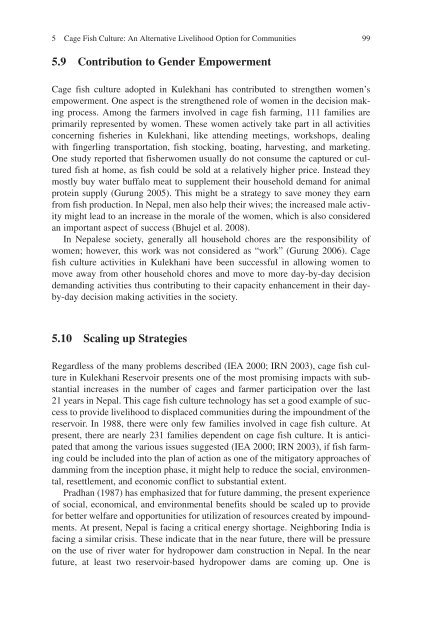Success Stories In Asian Aquaculture - Library - Network of ...
Success Stories In Asian Aquaculture - Library - Network of ...
Success Stories In Asian Aquaculture - Library - Network of ...
- No tags were found...
You also want an ePaper? Increase the reach of your titles
YUMPU automatically turns print PDFs into web optimized ePapers that Google loves.
5 Cage Fish Culture: An Alternative Livelihood Option for Communities995.9 Contribution to Gender EmpowermentCage fish culture adopted in Kulekhani has contributed to strengthen women’sempowerment. One aspect is the strengthened role <strong>of</strong> women in the decision makingprocess. Among the farmers involved in cage fish farming, 111 families areprimarily represented by women. These women actively take part in all activitiesconcerning fisheries in Kulekhani, like attending meetings, workshops, dealingwith fingerling transportation, fish stocking, boating, harvesting, and marketing.One study reported that fisherwomen usually do not consume the captured or culturedfish at home, as fish could be sold at a relatively higher price. <strong>In</strong>stead theymostly buy water buffalo meat to supplement their household demand for animalprotein supply (Gurung 2005) . This might be a strategy to save money they earnfrom fish production. <strong>In</strong> Nepal, men also help their wives; the increased male activitymight lead to an increase in the morale <strong>of</strong> the women, which is also consideredan important aspect <strong>of</strong> success (Bhujel et al. 2008) .<strong>In</strong> Nepalese society, generally all household chores are the responsibility <strong>of</strong>women; however, this work was not considered as “work” (Gurung 2006) . Cagefish culture activities in Kulekhani have been successful in allowing women tomove away from other household chores and move to more day-by-day decisiondemanding activities thus contributing to their capacity enhancement in their dayby-daydecision making activities in the society.5.10 Scaling up StrategiesRegardless <strong>of</strong> the many problems described (IEA 2000 ; IRN 2003) , cage fish culturein Kulekhani Reservoir presents one <strong>of</strong> the most promising impacts with substantialincreases in the number <strong>of</strong> cages and farmer participation over the last21 years in Nepal. This cage fish culture technology has set a good example <strong>of</strong> successto provide livelihood to displaced communities during the impoundment <strong>of</strong> thereservoir. <strong>In</strong> 1988, there were only few families involved in cage fish culture. Atpresent, there are nearly 231 families dependent on cage fish culture. It is anticipatedthat among the various issues suggested (IEA 2000 ; IRN 2003) , if fish farmingcould be included into the plan <strong>of</strong> action as one <strong>of</strong> the mitigatory approaches <strong>of</strong>damming from the inception phase, it might help to reduce the social, environmental,resettlement, and economic conflict to substantial extent.Pradhan (1987) has emphasized that for future damming, the present experience<strong>of</strong> social, economical, and environmental benefits should be scaled up to providefor better welfare and opportunities for utilization <strong>of</strong> resources created by impoundments.At present, Nepal is facing a critical energy shortage. Neighboring <strong>In</strong>dia isfacing a similar crisis. These indicate that in the near future, there will be pressureon the use <strong>of</strong> river water for hydropower dam construction in Nepal. <strong>In</strong> the nearfuture, at least two reservoir-based hydropower dams are coming up. One is
















